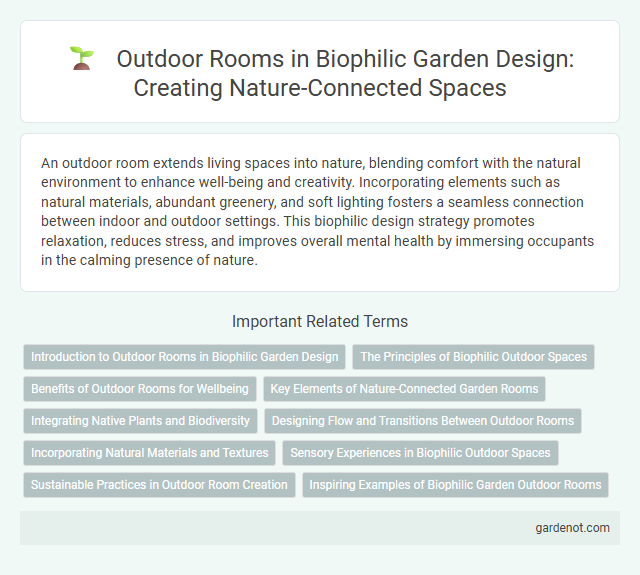An outdoor room extends living spaces into nature, blending comfort with the natural environment to enhance well-being and creativity. Incorporating elements such as natural materials, abundant greenery, and soft lighting fosters a seamless connection between indoor and outdoor settings. This biophilic design strategy promotes relaxation, reduces stress, and improves overall mental health by immersing occupants in the calming presence of nature.
Introduction to Outdoor Rooms in Biophilic Garden Design
Outdoor rooms in biophilic garden design create immersive natural spaces that blend architecture with the environment, enhancing human connection to nature. These outdoor rooms utilize elements such as native plants, natural materials, and sensory features to promote well-being, reduce stress, and improve air quality. Integrating outdoor rooms into biophilic gardens supports biodiversity while providing functional living areas that foster relaxation and social interaction.
The Principles of Biophilic Outdoor Spaces
Biophilic outdoor spaces emphasize natural elements such as sunlight, vegetation, water features, and organic materials to enhance human well-being and environmental connectivity. Key principles include integrating diverse plant species, creating layered spatial arrangements for comfort and privacy, and ensuring seamless indoor-outdoor transitions that foster sensory engagement. Incorporating natural textures, varying topography, and wildlife habitats supports biodiversity while promoting restorative experiences and psychological benefits.
Benefits of Outdoor Rooms for Wellbeing
Outdoor rooms in biophilic design enhance wellbeing by fostering a strong connection with nature, reducing stress levels, and improving mental clarity. Exposure to natural elements such as fresh air, sunlight, and greenery within these spaces stimulates the production of serotonin, promoting mood elevation and relaxation. Incorporating outdoor rooms also supports physical health through increased opportunities for movement and social interaction.
Key Elements of Nature-Connected Garden Rooms
Outdoor rooms designed with biophilic principles integrate natural elements such as native plants, natural stone, and water features to create immersive, sensory-rich environments. Key elements include ample greenery that promotes biodiversity, natural light to enhance mood and circadian rhythms, and organic materials that provide tactile connection to nature. Incorporating these features supports wellbeing by fostering relaxation, creativity, and environmental harmony.
Integrating Native Plants and Biodiversity
Integrating native plants into outdoor rooms enhances biodiversity by supporting local wildlife and promoting ecological balance. Native species require less maintenance and water, making them sustainable choices that thrive in natural conditions. Thoughtful planting creates a seamless connection between built environments and native ecosystems, fostering a biophilic experience that benefits both people and nature.
Designing Flow and Transitions Between Outdoor Rooms
Designing flow and transitions between outdoor rooms enhances the seamless connection in biophilic design by integrating natural elements, such as native plants and textured materials, that guide movement while maintaining harmony with the environment. Utilizing varying levels, lighting, and unobstructed sightlines creates fluid pathways that encourage exploration and relaxation. Thoughtful placement of furniture and natural partitions supports functional zones, promoting both privacy and social interaction within distinct outdoor areas.
Incorporating Natural Materials and Textures
Incorporating natural materials and textures in an outdoor room enhances biophilic design by creating a seamless connection between indoor and outdoor environments. Elements such as reclaimed wood, stone, bamboo, and woven fibers introduce organic textures that promote sensory engagement and environmental harmony. These materials not only contribute to sustainability but also foster mental well-being by invoking nature's calming effects in outdoor living spaces.
Sensory Experiences in Biophilic Outdoor Spaces
Outdoor rooms in biophilic design amplify sensory experiences by integrating natural elements such as textured wood, aromatic plants, and flowing water features that engage touch, smell, and sound. These sensory cues promote relaxation and enhance psychological well-being by reconnecting individuals with nature. Incorporating variable light patterns and natural materials further enriches visual and tactile stimulation, fostering a harmonious outdoor sanctuary.
Sustainable Practices in Outdoor Room Creation
Integrating sustainable practices in outdoor room creation enhances environmental harmony and resource efficiency by utilizing locally sourced materials, native plants, and permeable surfaces to reduce ecological impact. Solar-powered lighting and efficient water management systems such as rainwater harvesting and drip irrigation promote energy conservation and water sustainability. Designing with biophilic principles fosters a resilient outdoor space that supports biodiversity and human well-being.
Inspiring Examples of Biophilic Garden Outdoor Rooms
Biophilic garden outdoor rooms blend natural elements with functional living spaces, featuring lush greenery, natural stone pathways, and water features that enhance sensory experiences and promote well-being. Examples include vertical gardens that maximize limited space, pergolas intertwined with climbing plants, and outdoor seating areas surrounded by native flora to create immersive nature connections. Incorporating sustainable materials and seasonal plants further strengthens the harmony between human habitats and the environment in these outdoor rooms.
Outdoor room Infographic

 gardenot.com
gardenot.com